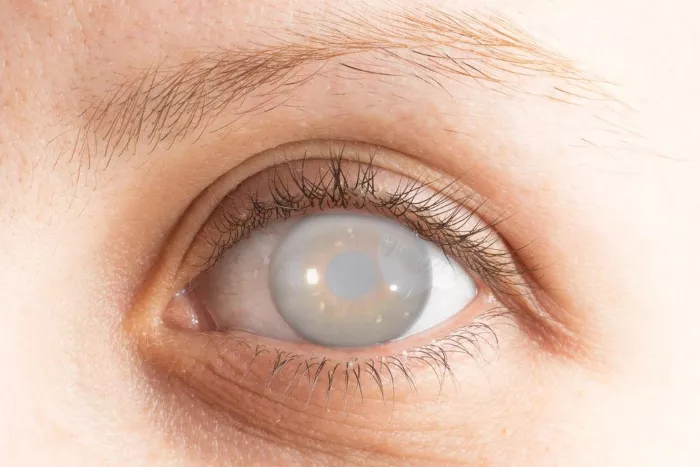Cataracts are one of the most common eye conditions worldwide, affecting millions of people as they age. But what exactly causes the eye’s normally clear lens to become cloudy? This comprehensive guide examines all the known causes and risk factors for cataract development.
Understanding How Cataracts Form
The eye’s lens works much like a camera lens, focusing light onto the retina to create clear images. A healthy lens is made up of precisely arranged proteins that maintain transparency. Cataracts develop when these proteins begin to clump together, creating cloudy areas that scatter light and impair vision.
This clouding process typically happens gradually over years. You might first notice slight blurring of vision, difficulty seeing at night, or colors appearing less vibrant. As the cataract progresses, these symptoms worsen until vision becomes significantly impaired.
Primary Causes of Cataracts
1. Age-Related Cataracts (Most Common)
The natural aging process is the number one cause of cataracts. After age 40, the proteins in our eye lenses begin breaking down:
By age 60: About 50% of people have some cataract development
By age 75: Nearly 70% have visually significant cataracts
After age 80: Over 90% will develop cataracts
This occurs because the eye’s natural antioxidant defenses weaken with age, allowing oxidative damage to accumulate in the lens.
2. UV Radiation Exposure
Prolonged exposure to sunlight’s ultraviolet rays significantly increases cataract risk:
- UVB rays are particularly damaging to lens proteins
- People who spend extensive time outdoors without eye protection develop cataracts earlier
- The risk increases with higher altitude living and proximity to the equator
3. Diabetes and Metabolic Disorders
People with diabetes develop cataracts up to 10 years earlier than average due to:
- High blood sugar levels causing lens swelling
- Sorbitol accumulation damaging lens cells
- Increased oxidative stress throughout the body
Other metabolic conditions like galactosemia also accelerate cataract formation.
4. Eye Trauma and Injury
Physical damage to the eye can lead to traumatic cataracts:
- Blunt force trauma (sports injuries, accidents)
- Penetrating eye wounds
- Electrical shocks
- Radiation exposure
- Chemical burns
These cataracts may develop immediately after injury or years later.
5. Medications and Toxins
Certain substances are known to promote cataract development:
- Corticosteroids (especially with long-term use)
- Chlorpromazine (antipsychotic medication)
- Amiodarone (heart medication)
- Statin cholesterol drugs (controversial link)
- Heavy smoking (toxins in cigarette smoke)
- Excessive alcohol consumption
6. Congenital and Childhood Cataracts
Some babies are born with cataracts or develop them in childhood due to:
- Genetic disorders (Down syndrome, Marfan syndrome)
- Maternal infections during pregnancy (rubella, herpes)
- Metabolic disorders present at birth
- Chromosomal abnormalities
Additional Risk Factors
Several other factors can increase your likelihood of developing cataracts:
Nutritional Deficiencies
Diets low in antioxidants may accelerate cataract formation:
- Vitamin C deficiency
- Low vitamin E intake
- Inadequate lutein and zeaxanthin (eye-protective carotenoids)
Eye Conditions and Surgeries
Certain ocular issues predispose to cataracts:
- Chronic uveitis (eye inflammation)
- Previous eye surgeries
- High myopia (severe nearsightedness)
- Retinal detachment history
Lifestyle Factors
Modern research has identified several behavioral risks:
- Prolonged computer/screen use (controversial)
- Dehydration and poor fluid intake
- Obesity and metabolic syndrome
- Chronic stress and poor sleep
The Science Behind Cataract Formation
At the molecular level, cataracts develop through several key processes:
Protein Denaturation: Lens proteins lose their precise structure and clump together
Oxidative Damage: Free radicals attack lens cells faster than antioxidants can neutralize them
Glycation: Sugar molecules bond abnormally to lens proteins
Membrane Changes: Lens cell membranes become less flexible and permeable
These changes cause light scattering instead of proper focusing, resulting in the classic symptoms of cataracts.
Prevention Strategies
While some cataract causes are unavoidable, you can reduce your risk by:
- Wearing UV-blocking sunglasses outdoors
- Maintaining healthy blood sugar levels
- Eating antioxidant-rich fruits and vegetables
- Quitting smoking and limiting alcohol
- Getting regular comprehensive eye exams
When to Seek Treatment
Consult an ophthalmologist if you experience:
- Progressive blurring of vision
- Increasing difficulty with night driving
- Frequent changes in eyeglass prescriptions
- Problems with glare or halos around lights
- Fading or yellowing of colors
Modern cataract surgery is highly successful, with most patients regaining excellent vision.
Conclusion
Cataracts develop from a combination of aging, environmental exposures, health conditions, and genetic factors. While they’re extremely common in older adults, understanding the causes can help you take preventive measures and seek treatment at the optimal time. Regular eye exams remain the best way to monitor lens health and maintain clear vision throughout your life.
Related topics:
Dos And Don’ts After You Get A Cataract Removed
Can You Really Remove Cataracts Naturally?
Can You Fly After Having Cataract Surgery?


